The kimono: East Meets West
← Back to Blog
You may think the kimono, in its sheer and delicate form is a no-go for the winter months. But high street stores are still stocking up on the billowy garment, and it’s an ideal statement piece for the party season. If you’ve fallen out of love with that sparkly red or black number that beckons at every year at the annual Office Christmas party, it’s time to try something new. A little more cool and casual, the kimono teamed with a pair of skinny jeans or cords is the perfect antidote to the sickly sweet Christmas jumper or that sequin dress that’s been worn one too many times.
The kimono that has filtered into the high esteem of Western fashion is of course a far cry from the original, enduring symbol of Japanese culture. Originally worn by the commoners, or as an undergarment by the aristocracy, the kimono became the principal item of dress for all classes and both sexes in the 16th Century.
Traditional kimonos are straight-seamed, full-length garments and are worn wrapped left side over right and secured with a sash called an obi. The kimonos seen in British high street stores are usually open at the front and are left to hang loose.
The most significant feature of the traditional kimono however, is not the cut, but the intricate pattern on the surface. While the historic technique of resist dying, yuzen, is used to create patterns over large areas of the silk kimono, many of the modern westernized pieces, made of velvet or synthetic materials are decorated with embroidery and devore.
Like other Japanese art forms, the traditional garment has symbolic connotations. The use of motifs in dress is part and parcel of the Japanese belief in the literal, as well as the figurative power of images. The motif usually alludes to the attributes of the wearer, reflects particular emotions or corresponds to the season in which it’s being worn.
Designs are often inspired by nature and in spring the silk is adorned with cherry blossoms and butterflies whereas in summer, watery designs are usually worn. The russet leaf of the Japanese maple is a traditional autumn motif and the bamboo, pine trees and plum blossoms are popular in Winter.
Perhaps less symbolic, but still thoroughly inspired by the natural world is this floral Topshop kimono.

The crane, believed to inhabit the land of the immortal, often adorns traditional kimonos and is a symbol of longevity. The colour is also carries an important cultural and metaphorical message, and dyes are very much seen to symbolise the spirit of the plants from which they are extracted.
Purple dye, for example, derived from the murasaki plant, symbolizes undying love as the roots of the plant are very long. One of the most popular colours for the kimono however is red which, much like in the West, has connotations with youthful glamour and allure. Here’s a rich red devore kimono from River Island.
The new kimono that has become a trend in the Western world has evolved in a multitude of ways from its Eastern counterpart, with its additional fringing, new, shorter length, looser shape, and material. There are however, some characteristics that have remained not too dissimilar to the traditional Japanese garment. There are colours in abundance, floral motifs and wide, billowy sleeves. It’s a kimoyes for the kimono!
Rosie Webber –



